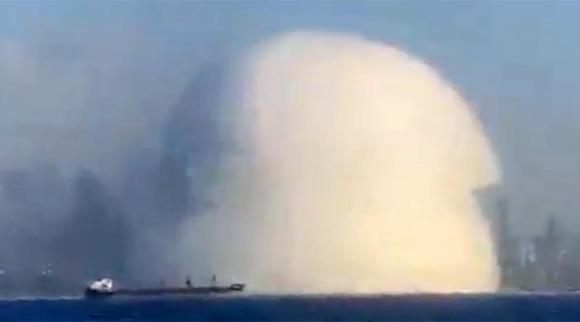Images of the terrible explosion in Lebanon drew attention to that troubled country. Although from British sources, it would appear that the explosion was due to the neglect of a welder worker, the accident shook the country with millions of dollars in damage and over 90% of the damaged hotels.
For years Lebanon has been undergoing a situation of profound economic and political crisis that could easily be resolved thanks to the exploitation of the offshore oil and gas deposits located in a maritime border area disputed with Israel. The offshore basins of the eastern Mediterranean have become a further point of the Israeli-Lebanese conflict, as both sides resolutely insist on the dispute over the maritime borders. In fact, the two countries have been at war since 2006 and only a contingent of blue Basques intervenes along the border.
The Lebanese situation
Lebanon, the Middle Eastern Switzerland, as it was called in the 60s, following the proclamation of Israel's independence and the following war with the Arab League, more than 100.000 Palestinian refugees fleeing migrated. This, together with Pan-Arab nationalist regurgitations, led to the first Lebanese civil war of 1958. Other refugees joined in the following years leading to an ethnic imbalance in which the previous Christian majority was replaced by the Muslim Arab majority with about two million Palestinian refugees. The long civil war between 1975 and 1990 was inevitable, with militias made up of Maronite Christians and a coalition made up of Palestinians, Lebanese Sunni Muslims, Shiites (Amal) and Druze.
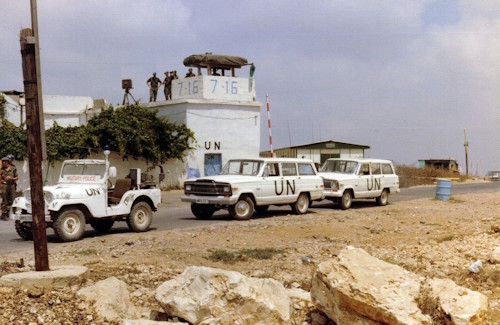 In 1976 the Arab League, following the Riyāḍ agreement of October 21, 1976, authorized the intervention of one Arab Deterrent Force (FAD) with a Syrian majority, who managed to forcefully restore a temporary and fragile peace in Lebanon. On March 14, 1978, Israel launched Operation Litani, occupying the area south of the country with more than 25.000 troops to create a buffer belt that would keep Palestinian militant groups, particularly the PLO, away from the border with Israel. The UN then decided to create a United Nations Interposition Force in Lebanon (UNIFIL) to strengthen its mandate and restore peace and sovereignty in the country.
In 1976 the Arab League, following the Riyāḍ agreement of October 21, 1976, authorized the intervention of one Arab Deterrent Force (FAD) with a Syrian majority, who managed to forcefully restore a temporary and fragile peace in Lebanon. On March 14, 1978, Israel launched Operation Litani, occupying the area south of the country with more than 25.000 troops to create a buffer belt that would keep Palestinian militant groups, particularly the PLO, away from the border with Israel. The UN then decided to create a United Nations Interposition Force in Lebanon (UNIFIL) to strengthen its mandate and restore peace and sovereignty in the country.
Israel, in 1982, with the support of the Christian-Maronites launched the military operation "Peace in Galilee" in order to eradicate the Palestinian armed presence from Lebanon, going beyond the south of Lebanon, to Beirut, where the PLO was based. . The newly elected President of the Republic Bashir Gemayel on September 14, 1982, nine days before the official investiture, fell victim to an attack (attributed to the Syrian National Socialist Party) and lost his life in the eastern part of Beirut. At this point there was an American, French and Italian international intervention that caused the PLO leadership to flee to neighboring countries.
Atrocities against the civilian population were perpetrated on both sides: from the massacre of Damur (1976) to the massacre in the refugee camps of Sabra and Shatila (1982), the first operated by Palestinian militants from the Tell al-Za'tar camp and the second by Christian units led by Elie Hobeika, which were not properly opposed by the Israeli army.
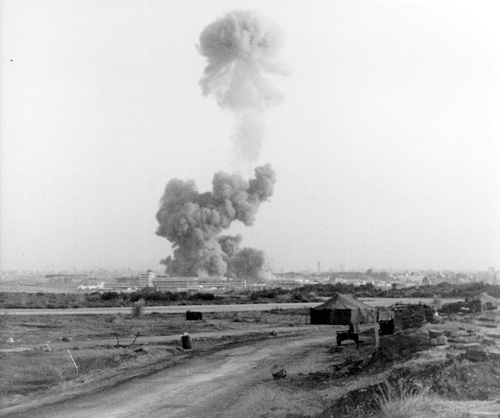 A striking episode was the double attack by the Hezbollah on the basis of the multinational force of 23 October 1983 which caused the death of 241 US marines and 56 French soldiers. This action caused the withdrawal of peacekeepers, leaving Lebanon in a creeping civil war.
A striking episode was the double attack by the Hezbollah on the basis of the multinational force of 23 October 1983 which caused the death of 241 US marines and 56 French soldiers. This action caused the withdrawal of peacekeepers, leaving Lebanon in a creeping civil war.
Following the Ta'if Accords of 1989 the war ended and the Second Lebanese Republic was presided over by General Michel Aoun, who in 1990 was deposed by the Syrians. The Syrian presence therefore became increasingly predominant. In 1994 the Lebanese Forces movement, which represented the most radical Christians, was banned. Following the assassination of former Sunni Prime Minister Rafīq al-Ḥarīrī in 2005, there was the so-called anti-Syrian "Cedar Revolution" which initiated the withdrawal of Syrian troops from the FAD (Arab Dissuasion Force). In July 2006, the Hezbollah attacked an Israeli army patrol near the village of Zar'it, killing 8 soldiers. In response, Israeli air bombardments began against many sensitive infrastructures such as Beirut airport, ports, power plants and major land routes to Syria, neighborhoods in the southern suburbs of Beirut and several villages in southern Lebanon, with thousands of civilian casualties.
During the clashes, the Hezbollah launched thousands of Chinese-type cluster bomb rockets on Israeli territory, causing panic and casualties among the civilian population. On 11 August 2006, after weeks of attempts to obtain a truce between the parties to allow the opening of humanitarian corridors in favor of the Lebanese civilian population, the United Nations Security Council unanimously voted on Resolution 1701. The text of the resolution called for the immediate cessation of hostilities between Israel and Hezbollah, the withdrawal of Israeli troops from southern Lebanon, in conjunction with the deployment of regular Lebanese troops and UNIFIL in the area with the creation of a buffer zone "free from any armed personnel other than the United Nations and the regular Lebanese armed forces ”for 12 miles between the Israeli-Lebanese border and the Litani River.
 The second UNIFIL mission (UNIFIL 2)
The second UNIFIL mission (UNIFIL 2)
On August 25, 2006, the European Union decided to send about seven thousand European troops to form the central nucleus of the multinational interposition force in southern Lebanon (second UNIFIL mission). The command of the mission, initially led by France, passed to Italy in February 2007 (Operation Leonte), standing between the two sides with a passive profile to make sure that this area was not used for offensive activities of any kind. The task of disarming the armed groups remained with the Lebanese regular forces, also responsible for controlling the Syrian border, a source of arms supply for the Hezbollah.
After fresh clashes between Shiites and Sunnis in early May 2008, an international mediation led by Qatar allowed local political factions to agree for the election of General Michel Suleiman to preside over the republic and for the formation of a government of national unity. , in view of the parliamentary elections scheduled for spring 2009.
In 2011, during the Syrian civil war, the clash between Sunni and Shiite factions flared up. The trespassing of the Syrian civil war in Lebanon not only involved villages on the Syrian border, but also large urban centers, including Beirut, Sidon and Tripoli where armed clashes, kidnappings and attacks took place.
But what was the impact of the Syrian crisis in Lebanon?
In August 2012, Prime Minister Najib Miqati claimed that internal pushes existed to drag Lebanon increasingly into the Syrian conflict. The situation became increasingly critical and required leaders of all factions to cooperate to protect Lebanon, asking for help from the international community to avoid being another theater in the Syrian civil war.
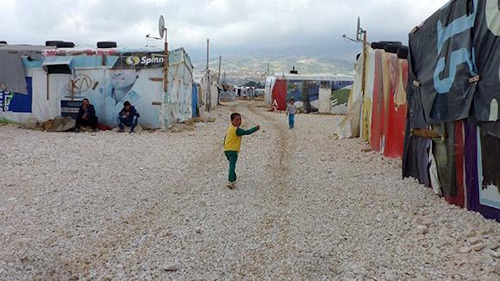 In fact, the Syrian civil war and its internal impact favored the polarization of Lebanese politics. On the one hand the Alliance of March 14, dominated by Christian and Sunni parties, largely in solidarity with the Syrian opposition to Bashar Al-Assad, on the other the pro Assad parties.
In fact, the Syrian civil war and its internal impact favored the polarization of Lebanese politics. On the one hand the Alliance of March 14, dominated by Christian and Sunni parties, largely in solidarity with the Syrian opposition to Bashar Al-Assad, on the other the pro Assad parties.
Since February 2013, the number of Syrian refugees in Lebanon has risen to over 180000, creating many internal problems. A not negligible factor in Lebanese internal stability is the relationship between Hezbollah and the Syrian regime, which has played an increasingly destabilizing role after 2011; initially the first ones had a low level involvement but, from April to June 2013, 1.700 Hezbollah fighters worked more and more incisively alongside the regime and in other countries of the region, such as Yemen (alongside the Houtis) and the Iraq fueling friction between Sunni-Shiite factions. This deployment does not hide Iranian interests in the Middle East region, opposed by the Arab countries of the GCC who see Hezbollah as an annoying stone in the shoe. For its part, the EU perceived the intrusiveness and adopted policies aimed at strengthening the government and the official Lebanese army.
In Lebanon, there are other internal conflicts between pro-Syrian Alawites and Sunni Islamic factions that often escalate into armed conflict. Following jihadist attacks in Syria, such as those of Jabhat al-Nusra against Hezbollah forces, attacks on both Hezbollah structures and the Lebanese army have multiplied in Lebanon. In addition to the political aspects, this situation of instability has had important economic repercussions made even more dramatic by the social and political costs of managing the refugees. The labor market collapsed as did the influx of tourists to historic cities, already threatened by internal terrorism, which fell by 40% between 2010 and 2013. In 2016, the increase in public debt reached 148% of GDP. Similarly, the number of Syrian refugees has increased significantly. UNHCR estimated that in November 2011, 8875 refugees were registered by UNHCR; almost all Iraqis, and only 1% were from Syria.
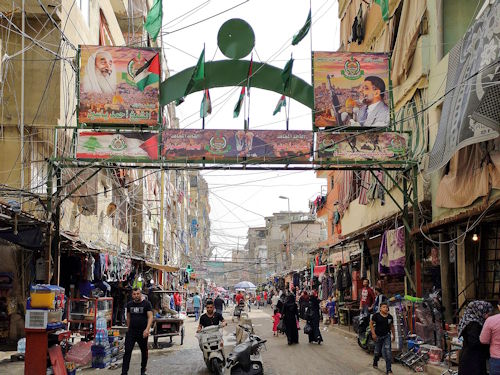 In the following years the situation changed radically, passing to over 33000 Syrians in July 2012, 180000 in 2013 up to a peak of over 1,1 million in 2014 (UNHCR data, 2018). Most of them found employment in agriculture (28%), in domestic services (36%) and in construction. The use in agriculture finds reason in the fact that the Syrians came largely from the Bekaa valley, an agricultural area of Syrian excellence. The question that arises is whether this imbalance will change local politics, further exacerbating the fragile internal tensions.
In the following years the situation changed radically, passing to over 33000 Syrians in July 2012, 180000 in 2013 up to a peak of over 1,1 million in 2014 (UNHCR data, 2018). Most of them found employment in agriculture (28%), in domestic services (36%) and in construction. The use in agriculture finds reason in the fact that the Syrians came largely from the Bekaa valley, an agricultural area of Syrian excellence. The question that arises is whether this imbalance will change local politics, further exacerbating the fragile internal tensions.
A sea of oil and gas
The Hezbollah appear to be continuing an aggressive policy by attacking Israeli platforms. The claimed area extends over a triangular expanse of about 800 km², rich in gas and oil. Nothing was worth action by the United States and the United Nations to mediate a peaceful settlement on the maritime controversy in the area. Both Lebanon and Israel have claimed this territory for decades, but the dispute has been exacerbated as a result of separate and signed maritime agreements with Cyprus, signed by Lebanon in 2007 and Israel in 2010, which caused a diplomatic quarrel which ended up lead them to accuse each other of territorial theft. International law provides that, in cases where two states share a maritime area or a border, it is customary to divide the territory equally between states, but this does not seem to be the case.
The eastern Mediterranean has in its vast and still unused seabed fossil fuel deposits. At stake in the Levant Basin between Egypt and Syria there would be an availability of fossil fuel equal to 122 trillion cubic meters of natural gas and an amount of oil equivalent to 1,7 billion barrels.
In 2017 Lebanon gave its consent to the exploration of the seabed, granting Eni (Italy), Novatek (Russia) and Total (France) the first blocks into which the area under Lebanese jurisdiction was divided. This did not please Israel, which believes that those territorial waters are its own. Lebanon has sent a letter to the UN which strongly rejects the map with new maritime borders approved by Tel Aviv. Israel with the support of the United States raises its tone, justifying itself with the attacks of Hezbollah and the situation is rapidly deteriorating with a steady increase in instability in the area and consequent migrations to Europe. There are over $ 600 billion at stake and neither of them will likely want to give up from its positions.
In the meantime, Turkey faces the area and could claim its share.
Andrea Mucedola (http://www.ocean4future.org)
Photo: Twitter / Marco K / US DoD / Navy / Alessandra Mulas / hardscarf

